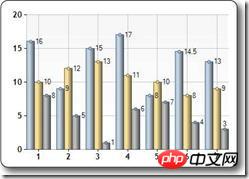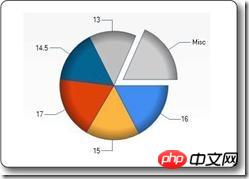Share ASP.NET study notes (8) WebPages Helper
ASP.NET Web Pages - Helpers
Web Helpers greatly simplify web development and common programming tasks.
ASP.NET Helpers
ASP.NET helpers are components accessible with a few simple lines of Razor code.
You can build your own helpers using Razor syntax stored in a .cshtml file, or use the built-in ASP.NET helpers.
In the following chapters of this tutorial, you will learn how to use Razor helpers.
Here are brief descriptions of some useful Razor helpers:
WebGrid Helpers
The WebGrid helpers simplify the way you display data:
Automatic Create an HTML table to display data
Supports different formatting options
Supports paginated display of data (first page, next page, previous page, last page)
Supports sorting by clicking on the list title
Chart Helper
"Chart Helper" can display different types of chart images with various formatting options and labels.


The data source displayed by the Chart helper can be an array, database or file.
WebMail Helper
WebMail Helper provides the function of sending emails using SMTP (Simple Mail Transfer Protocol).
WebImage Helper
WebImage Helper provides functions for managing images in web pages.
Keywords: flip, rotate, scale, watermark.
Third-Party Helpers
With Razor, you can leverage built-in or third-party helpers to simplify email, databases, multimedia, social networking, and many other problems such as navigation and network security).
Installing Helpers
WebMatrix already includes some helpers, and you can install others manually.
In the WebPages Helpers Reference Manual at w3cschool.cc, you can see a convenient reference manual that covers the built-in helpers and other toolkits that can be added to the ASP.NET Web Helpers Library through manual installation Helper in .
If you created a website in WebMatrix, follow these steps to install the helper:
In WebMatrix, open the Site workspace.
Click Web Pages Administration.
Log in to Web Pages Administration using password *.
Use the Search Area to search for helpers.
Click Install to install the helper you need.
(* If this is your first time using Web Pages Administration, you will be prompted to create a password.)

[Related recommendations]
1. Share ASP.NET study notes (6) WebPages files
2. Share ASP.NET study notes (1)--WebPages Razor
3. Share ASP.NET study notes (2)--WebPages Introduction
4. Share ASP.NET study notes (3) WebPages layout
5. Share ASP.NET study notes (4) folder
The above is the detailed content of Share ASP.NET study notes (8) WebPages Helper. For more information, please follow other related articles on the PHP Chinese website!

Hot AI Tools

Undresser.AI Undress
AI-powered app for creating realistic nude photos

AI Clothes Remover
Online AI tool for removing clothes from photos.

Undress AI Tool
Undress images for free

Clothoff.io
AI clothes remover

Video Face Swap
Swap faces in any video effortlessly with our completely free AI face swap tool!

Hot Article

Hot Tools

Notepad++7.3.1
Easy-to-use and free code editor

SublimeText3 Chinese version
Chinese version, very easy to use

Zend Studio 13.0.1
Powerful PHP integrated development environment

Dreamweaver CS6
Visual web development tools

SublimeText3 Mac version
God-level code editing software (SublimeText3)

Hot Topics
 What is the role of char in C strings
Apr 03, 2025 pm 03:15 PM
What is the role of char in C strings
Apr 03, 2025 pm 03:15 PM
In C, the char type is used in strings: 1. Store a single character; 2. Use an array to represent a string and end with a null terminator; 3. Operate through a string operation function; 4. Read or output a string from the keyboard.
 How to use various symbols in C language
Apr 03, 2025 pm 04:48 PM
How to use various symbols in C language
Apr 03, 2025 pm 04:48 PM
The usage methods of symbols in C language cover arithmetic, assignment, conditions, logic, bit operators, etc. Arithmetic operators are used for basic mathematical operations, assignment operators are used for assignment and addition, subtraction, multiplication and division assignment, condition operators are used for different operations according to conditions, logical operators are used for logical operations, bit operators are used for bit-level operations, and special constants are used to represent null pointers, end-of-file markers, and non-numeric values.
 How to handle special characters in C language
Apr 03, 2025 pm 03:18 PM
How to handle special characters in C language
Apr 03, 2025 pm 03:18 PM
In C language, special characters are processed through escape sequences, such as: \n represents line breaks. \t means tab character. Use escape sequences or character constants to represent special characters, such as char c = '\n'. Note that the backslash needs to be escaped twice. Different platforms and compilers may have different escape sequences, please consult the documentation.
 The difference between multithreading and asynchronous c#
Apr 03, 2025 pm 02:57 PM
The difference between multithreading and asynchronous c#
Apr 03, 2025 pm 02:57 PM
The difference between multithreading and asynchronous is that multithreading executes multiple threads at the same time, while asynchronously performs operations without blocking the current thread. Multithreading is used for compute-intensive tasks, while asynchronously is used for user interaction. The advantage of multi-threading is to improve computing performance, while the advantage of asynchronous is to not block UI threads. Choosing multithreading or asynchronous depends on the nature of the task: Computation-intensive tasks use multithreading, tasks that interact with external resources and need to keep UI responsiveness use asynchronous.
 The difference between char and wchar_t in C language
Apr 03, 2025 pm 03:09 PM
The difference between char and wchar_t in C language
Apr 03, 2025 pm 03:09 PM
In C language, the main difference between char and wchar_t is character encoding: char uses ASCII or extends ASCII, wchar_t uses Unicode; char takes up 1-2 bytes, wchar_t takes up 2-4 bytes; char is suitable for English text, wchar_t is suitable for multilingual text; char is widely supported, wchar_t depends on whether the compiler and operating system support Unicode; char is limited in character range, wchar_t has a larger character range, and special functions are used for arithmetic operations.
 How to convert char in C language
Apr 03, 2025 pm 03:21 PM
How to convert char in C language
Apr 03, 2025 pm 03:21 PM
In C language, char type conversion can be directly converted to another type by: casting: using casting characters. Automatic type conversion: When one type of data can accommodate another type of value, the compiler automatically converts it.
 What is the function of C language sum?
Apr 03, 2025 pm 02:21 PM
What is the function of C language sum?
Apr 03, 2025 pm 02:21 PM
There is no built-in sum function in C language, so it needs to be written by yourself. Sum can be achieved by traversing the array and accumulating elements: Loop version: Sum is calculated using for loop and array length. Pointer version: Use pointers to point to array elements, and efficient summing is achieved through self-increment pointers. Dynamically allocate array version: Dynamically allocate arrays and manage memory yourself, ensuring that allocated memory is freed to prevent memory leaks.
 How to use char array in C language
Apr 03, 2025 pm 03:24 PM
How to use char array in C language
Apr 03, 2025 pm 03:24 PM
The char array stores character sequences in C language and is declared as char array_name[size]. The access element is passed through the subscript operator, and the element ends with the null terminator '\0', which represents the end point of the string. The C language provides a variety of string manipulation functions, such as strlen(), strcpy(), strcat() and strcmp().






